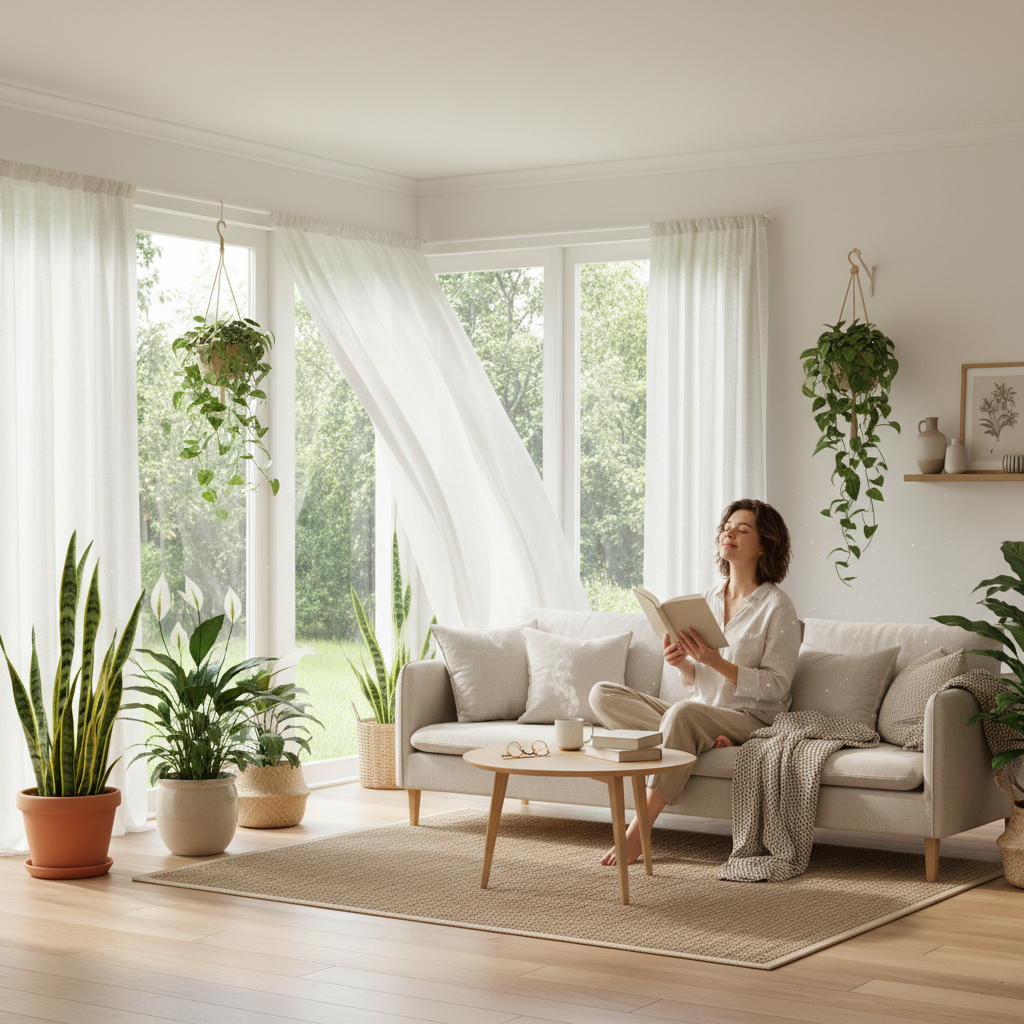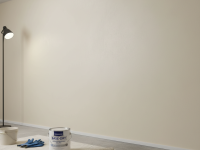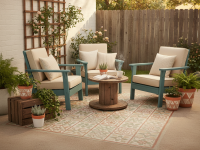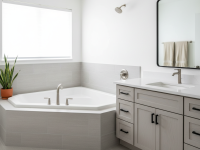Introduction: Your Indoor Sanctuary Deserves Fresh Air
Hey there, fellow homebodies! How much time do you spend indoors? If you’re anything like me, it’s a significant chunk of your day – working, relaxing, cooking, sleeping. And while we meticulously decorate our homes to be our cozy sanctuaries, have you ever stopped to think about the air you’re actually breathing inside those four walls?
It’s a bit of a wake-up call, but studies often show that indoor air can be significantly more polluted than outdoor air, even in bustling cities! Things like dust, pet dander, mold spores, volatile organic compounds (VOCs) from furniture and cleaning products, and even fumes from cooking can all linger, affecting our health in ways we might not even realize. Think about it: constant allergies, unexplained headaches, that perpetual stuffy nose, or just feeling a bit “off.” I’ve been there, and I know how frustrating it can be.
But here’s the good news: improving your indoor air quality doesn’t have to involve expensive gadgets or complicated systems. My own journey to a fresher, healthier home taught me that some of the most effective solutions are surprisingly simple, natural, and often quite beautiful. I’m excited to share my go-to strategies that have truly made a difference in my living space and, more importantly, in how I feel every single day. Let’s dive into some easy, natural ways to literally breathe new life into your home!
Ventilation is Your Best Friend (Seriously!)
This might sound ridiculously obvious, but it’s probably the most overlooked and most effective natural air quality booster: fresh air! I used to think opening windows was just for cooling or airing out a smell, but it’s so much more than that. It’s about replacing stagnant, pollutant-laden indoor air with cleaner outdoor air.
Embrace the Open Window Policy
- Daily Air Exchange: Make it a habit to open windows and doors for at least 5-10 minutes a day, even in cooler weather. If you can, do it on opposite sides of your house to create a cross-breeze. You’ll literally feel the old air leave and the fresh air rush in. I personally love doing this first thing in the morning; it’s like my home is taking a deep breath.
- Post-Cooking & Post-Shower: Always use your kitchen exhaust fan when cooking, especially if you’re frying or high-heat searing. Similarly, turn on your bathroom fan during and after showers to whisk away excess moisture that can lead to mold and mildew. These tiny actions prevent a lot of pollutants and dampness from lingering.
- Seasonal Considerations: Even in winter, a quick “airing out” session can do wonders. Just be mindful of local air quality alerts; if outdoor air pollution is high (e.g., during wildfire season or heavy smog), you might want to keep windows closed and rely on other methods.
Unleash the Power of Houseplants
Okay, this is one of my favorite tips, and it’s backed by science (remember that famous NASA Clean Air Study?). Houseplants aren’t just pretty decor; they’re natural air purifiers, absorbing toxins and releasing oxygen. My own living room transformed when I started adding a few strategically placed plants.
My Go-To Air-Purifying Plants
- Snake Plant (Sansevieria trifasciata): Super low-maintenance and fantastic at removing toxins like formaldehyde, benzene, and trichloroethylene. Plus, they release oxygen at night, making them perfect for bedrooms.
- Spider Plant (Chlorophytum comosum): Another easy-care hero, great for removing formaldehyde and xylene. They produce “spiderettes” that you can propagate, so you’ll have an endless supply!
- Peace Lily (Spathiphyllum): Elegant and effective, Peace Lilies are excellent at filtering out ammonia, benzene, formaldehyde, and trichloroethylene. Just keep them out of reach of pets, as they can be toxic if ingested.
- Pothos (Epipremnum aureum): Often called “devil’s ivy” because it’s so hard to kill! Pothos is brilliant at absorbing formaldehyde, xylene, and benzene. Hang them in baskets or let them trail.
The key is to have a few plants, not just one. Aim for at least one plant per 100 square feet for noticeable effects. And remember, they’re living things – give them the light and water they need, and they’ll give you cleaner air in return.
Ditch the Chemicals: Embrace Natural Cleaning Solutions
This was a huge “aha!” moment for me. Many conventional cleaning products are loaded with volatile organic compounds (VOCs) and other harsh chemicals that evaporate into your air every time you spray, wipe, or scrub. Switching to natural alternatives was a game-changer for my sinuses and overall home air quality.
Simple Swaps for a Fresher Home
- DIY Cleaning Powerhouses: White vinegar, baking soda, and lemon juice are your best friends.
- All-purpose cleaner: Mix equal parts white vinegar and water with a few drops of essential oil (like lemon or tea tree) in a spray bottle.
- Odor absorber: A bowl of baking soda in the fridge or a sprinkled carpet for 15 minutes before vacuuming works wonders.
- Scrubbing paste: Baking soda mixed with a little water makes a gentle abrasive for sinks and tubs.
- Read Labels: When buying products like paints, new furniture, or even air fresheners, look for “low-VOC” or “zero-VOC” options. Off-gassing from new items can significantly impact air quality for weeks or even months.
- Be Mindful of Scents: While I love a good smell, many conventional air fresheners and scented candles release synthetic fragrances that can irritate airways. If you want a nice scent, consider diffusing pure essential oils (like lavender, lemon, or peppermint) or using beeswax candles, which some believe release negative ions that help purify the air.
Mastering Humidity: The Goldilocks Zone for Air Quality
Humidity is often an unsung hero (or villain) of indoor air quality. Too much and you’re inviting mold, mildew, and dust mites. Too little and you’re dealing with dry skin, irritated airways, and static electricity. My experience with a persistent stuffy nose taught me to pay attention to this balance.
Finding the Perfect Balance
- Target Range: Aim for indoor humidity levels between 30% and 50%. You can easily monitor this with an inexpensive hygrometer.
- Combatting High Humidity:
- Use exhaust fans in bathrooms and kitchens.
- Fix any leaks promptly (under sinks, leaky pipes).
- Consider a dehumidifier in damp areas like basements, especially in humid climates.
- Ensure proper ventilation after showering or cooking.
- Addressing Low Humidity:
- Place bowls of water near radiators or heating vents (evaporation adds moisture).
- More houseplants can help release moisture into the air.
- Use a humidifier during dry winter months, but clean it regularly to prevent mold growth.
I once had a small patch of mold under my sink because of a slow leak, and addressing the humidity (and the leak!) was crucial not just for fixing the problem, but for preventing it from coming back and affecting my air.
The Power of Regular Cleaning & Decluttering
It sounds basic, but consistent cleaning makes a massive difference. Dust, dander, and allergens don’t magically disappear; they accumulate, waiting to be disturbed and breathed in.
Your Cleaning Action Plan
- Dust with Damp Cloths: Dry dusting just redistributes particles. A damp cloth picks them up effectively.
- Vacuum Regularly: Use a vacuum cleaner with a HEPA filter, especially if you have pets or allergies. This traps fine particles rather than blowing them back into the air. Aim for at least once or twice a week.
- Wash Bedding & Curtains: Bedding collects dust mites and dander like crazy. Wash sheets weekly and curtains periodically.
- Reduce Clutter: Clutter provides more surfaces for dust to settle. The less stuff you have, the easier it is to keep clean. I noticed a significant difference in my bedroom air after a major decluttering session.
- Pet Care: Brush pets regularly (preferably outdoors) to minimize shedding and dander indoors. Clean pet beds often.
Beyond Plants: Other Natural Air Quality Boosters
While plants are fantastic, there are a few other natural elements you can introduce to your home that can contribute to a fresher environment.
- Activated Charcoal: These porous little wonders are amazing odor absorbers and can trap airborne toxins. I’ve tried activated charcoal bags in my closets, fridge, and even car, and they really do work for neutralizing lingering smells.
- Beeswax Candles: Unlike paraffin candles, which can release soot and VOCs, beeswax candles burn cleanly and, some believe, release negative ions that can bind with positively charged pollutants, causing them to fall out of the air. Plus, they smell subtly sweet and lovely.
- Salt Lamps: Himalayan salt lamps are often touted for their air-purifying properties, supposedly attracting water vapor and airborne particles. While scientific evidence is limited, many find their warm glow calming and they certainly don’t hurt!
Mind Your Habits: Small Changes, Big Impact
Finally, some of our daily habits can unwittingly contribute to poor indoor air quality. Being mindful of these can make a huge difference.
- No Smoking Indoors: This is probably the biggest one. Tobacco smoke is a major indoor air pollutant.
- Shoes Off at the Door: This simple rule prevents a surprising amount of dirt, pollen, pesticides, and other outdoor pollutants from being tracked into your home. This one was tough for me initially, but the “no shoes inside” rule is a simple win.
- Proper Food Storage: Keep food in airtight containers and dispose of garbage regularly to prevent odors and mold.
- Fireplace Use: If you have a fireplace, ensure it’s properly vented and use seasoned wood to minimize smoke and particulate matter indoors.
Conclusion: Breathe Better, Live Better
Improving your home’s indoor air quality naturally is not just about cleanliness; it’s about creating a healthier, more vibrant living environment for you and your loved ones. It’s about feeling that crisp, fresh sensation when you walk into a room, knowing you’re breathing air that supports your well-being.
You don’t need to overhaul everything at once. Start small. Pick one or two tips that resonate with you – maybe open your windows daily, or bring in a few air-purifying plants. Trust me, once you start implementing even a few of these, you’ll notice a positive shift not just in your home’s atmosphere, but in how you feel physically and mentally. Our homes are our havens; let’s make sure the air we breathe in them is as pure and refreshing as it can be. Happy breathing!




